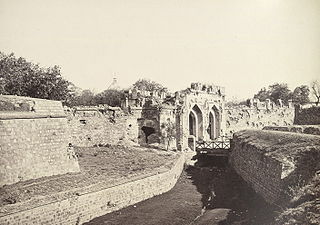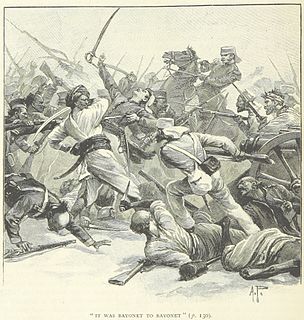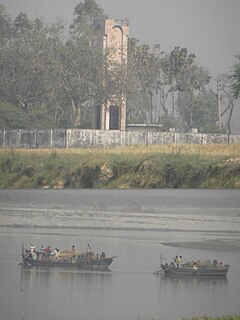 W
WThe 3rd Bengal Light Cavalry, also known as the 3rd Bengal Native Cavalry, was a locally recruited regiment of the East India Company's Bengal Army. Raised in 1797, the regiment took part in conflicts throughout British India, serving with distinction in the Second Anglo-Maratha War, the First Anglo-Afghan War and the First Anglo-Sikh War, earning various battle honours.
 W
WThe Siege of Arrah took place during the Indian Mutiny. It was the eight-day defence of a fortified outbuilding, occupied by a combination of 18 civilians and 50 members of the Bengal Military Police Battalion, against 2,500–3,000 mutinying Bengal Native Infantry sepoys from three regiments and an estimated 8,000 men from irregular forces commanded by Kunwar Singh, the local zamindar or chieftain who controlled the Jagdishpur estate.
 W
WThe Siege of Delhi was one of the decisive conflicts of the Indian rebellion of 1857.
 W
WThe Indian Rebellion of 1857 was a major, but ultimately unsuccessful, uprising in India in 1857–58 against the rule of the British East India Company, which functioned as a sovereign power on behalf of the British Crown. The rebellion began on 10 May 1857 in the form of a mutiny of sepoys of the Company's army in the garrison town of Meerut, 40 mi (64 km) northeast of Delhi. It then erupted into other mutinies and civilian rebellions chiefly in the upper Gangetic plain and central India, though incidents of revolt also occurred farther north and east. The rebellion posed a considerable threat to British power in that region, and was contained only with the rebels' defeat in Gwalior on 20 June 1858. On 1 November 1858, the British granted amnesty to all rebels not involved in murder, though they did not declare the hostilities to have formally ended until 8 July 1859. Its name is contested, and it is variously described as the Sepoy Mutiny, the Indian Mutiny, the Great Rebellion, the Revolt of 1857, the Indian Insurrection, and the First War of Independence.
 W
WThe Siege of Lucknow was the prolonged defence of the Residency within the city of Lucknow during the Indian Rebellion of 1857. After two successive relief attempts had reached the city, the defenders and civilians were evacuated from the Residency, which was then abandoned.
 W
WThe Battle of Najafgarh was an engagement during the Indian Rebellion of 1857, or First War of Indian Independence as it has since been termed in Indian histories of the events. It was a subsidiary event of the Siege of Delhi. A large Indian force sortied from Delhi, intending to attack the rear of the British force besieging the city. A detachment from the besiegers marched to intercept them, and defeated them while they were disordered by difficult terrain and by quarrels among their commanders.
 W
WPaina is a village and Nyaya Panchayat situated along the bank of Sarayu(Ghaghra) river in the eastern part of the state of Uttar Pradesh in India. It comes under administration of Barhaj Tehsil of Deoria District and Gorakhpur Division. It is located 33 km towards South from District headquarters Deoria and 340 km from State capital Lucknow.
 W
WShaheedan da Khu or Kalianwala Khu is a well near Ajnala in northwestern India. The bodies of Indian soldiers killed during the Sepoy mutiny of 1857 were disposed of here, over 60 of which were recovered in 2014.
 W
WThe Siege of Cawnpore was a key episode in the Indian rebellion of 1857. The besieged Company forces and civilians in Cawnpore were unprepared for an extended siege and surrendered to rebel forces under Nana Sahib, in return for a safe passage to Allahabad. However, their evacuation from Cawnpore turned into a massacre, and most of the men were killed. As an East India Company rescue force from Allahabad approached Cawnpore, 120 British women and children captured by the Sepoy forces were killed in what came to be known as the Bibighar Massacre, their remains being thrown down a nearby well in an attempt to hide the evidence. Following the recapture of Cawnpore and the discovery of the massacre, the angry Company forces engaged in widespread retaliation against captured rebel soldiers and local civilians. The murders greatly embittered the British rank-and-file against the Sepoy rebels and inspired the war cry "Remember Cawnpore!".
 W
WSikandar Bagh, formerly known by the British as Sikunder/Sikandra/Secundra Bagh, is a villa and garden enclosed by a fortified wall, with loopholes, gateway and corner bastions, approx. 150 yards square, c. 4.5 acres (1.8 ha), located in the city of Lucknow, Oudh, Uttar Pradesh, India. It was built by the last Nawab of Oudh, Wajid Ali Shah (1822–1887), as a summer residence. The name of the villa signifies '"Garden of Sikandar", perhaps after Alexander the Great, whose name lives on in this form in these parts, or perhaps after Sikandar Mahal Begum, the Nawab's favourite wife. It was stormed in 1857 by the British during the Indian Rebellion and witnessed within its walls the slaughter of all 2,200 sepoy mutineers who had made it a stronghold during their Siege of Lucknow. The site now houses the National Botanical Research Institute of India.